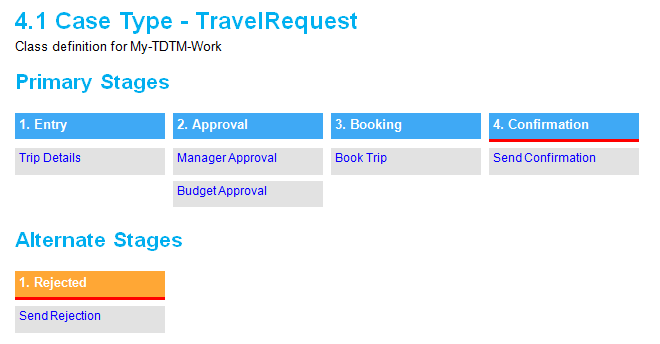Attachment support for requirements
Valid from Pega Version 7.1.6
Requirements now support attachments. You can add attachments from the Designer Studio > Application > Profile > Requirements landing page, the Add/Edit Requirement modal, or the requirement rule form.
Enhanced document generation
Valid from Pega Version 7.1.6
The following usability improvements have been made to documents generated by the Application Document Wizard:
- Stages and Processes now appear for case types that use Case Lifecycle Management. This diagram includes hyperlinks to corresponding sections in the document and is scoped to top-level processes only.

- All flows (excluding pyStartCase) referenced by a case type now appear in documents. This removes previous constraints on non-starting, draft, and checked out flows.
- Entity Relationship Diagrams (ERDs) are now embedded in documents as Visio objects.
- Sections without content are omitted from the generated document.
- Screenshots are labeled.
- Requirement text (Long Description) is included in the Requirements Matrix section.
- Linked requirements appear in context beneath their associated specification.
- Acceptance Criteria appears in context beneath the associated specification, report, or correspondence item.
PRServlet not required in PRPC URLs
Valid from Pega Version 7.1.6
PRServlet is no longer required in a URL when accessing PRPC. A URL typically written like this:
http://example.com/prweb/PRServlet?[QueryString]
Can instead be written like this:
http://example.com/prweb/?[QueryString]
Add additional columns to customized work history tables
Valid from Pega Version 7.1.6
The standard work history table, pc_history_work, contains two new columns that return the latitude and longitude coordinate location of the action that prompted the history. Mobile devices can display this location as a street address. If you have a customized work history table, add these two columns to it:
<decimal name="pxLatitude" size="19" scale="9"/><decimal name="pxLongitude" size="19" scale="9"/>
REST APIs added for management of agents and requestors
Valid from Pega Version 8.1
You can use new REST APIs to download a module version report or manage requestors and agents in Pega Platform™. For example, you can use a requestor REST API to end a requestor process, and you can use an agent REST API to start or stop an agent. These APIs allow external systems to report and manage Pega resources.
For more information, see Pega API for Pega Platform and Pega API.
MBeans deprecated in favor of Pega API
Valid from Pega Version 8.1
The use of MBeans for cluster management has been deprecated, although MBeans will continue to function for legacy deployments. The recommended best practice for automating system management is to use the Pega API. For more information, see Pega API.
Apache Ignite is no longer supported
Valid from Pega Version 8.1
Apache Ignite is no longer supported and has been replaced by Hazelcast Enterprise Edition 3.10 in embedded mode. If you used encryption with Apache Ignite, you can configure encryption on Hazelcast Enterprise Edition in the same way that you configured it for Apache Ignite.
For more information about encrypting nodes, see Enabling encrypted communication between nodes.
Automatically populate columns on import
Valid from Pega Version 8.1
If an imported archive file adds columns to existing tables, Pega Platform ™ can automatically expose and populate the new columns during the import. For more information, see Import wizard.
Automatically revalidate and save classes after upgrade
Valid from Pega Version 8.1
To automatically revalidate and save classes after an upgrade, edit the product rule definition. After you upgrade the application, the classes you specify are revalidated and saved under the application version context you provide. If the application version exists on the target system before the upgrade, the revalidate and save process is not called.
For more information about editing the product rule, see Specifying product rule deployment options.
Add and populate new indexes on import
Valid from Pega Version 8.1
If you import an archive that includes new indexes, use the Import wizard advanced mode to schedule a post-import job to automatically add and populate the new indexes. For more information, see Import wizard.

